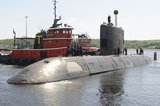US Navy's JSOW C-1 set for operational testing
The US Navy has completed integrated test and evaluation of its Joint Standoff Weapon (JSOW) C-1, according to an announcement on 12 January.
The JSOW C-1 is its first maritime, network-enabled weapon and it underwent the final developmental free flight test at the Sea Range at Point Mugu, California. The test demonstrated the weapon’s effectiveness against maritime moving targets, an essential capability to support the navy’s anti-surface warfare mission.
Capt. Jaime Engdahl, program manager, Precision Strike Weapons (PMA-201), said: 'As we pivot to the Pacific, our capability to employ networked precision strike across our kill chains and engage in offensive anti-surface warfare is key to maintaining our strategic dominance in that theatre.'
An update to the JSOW-C, the C-1 variant incorporates a two-way strike common weapon data link enabling a moving maritime target capability. It is equipped with an imaging infrared seeker and an autonomous target capability to attack targets with precision accuracy.
During the test the JSOW-C1, released from an F/A-18 Super Hornet, scored a direct hit to a moving maritime target and met all primary test objectives. This event proved the system’s readiness to begin operational tests next month.
When operational test commences, Air Test and Evaluation Squadron (VX) 9 will be responsible for implementing real-world scenarios using the JSOW C-1 to verify that the weapon’s capability, suitability and design will be fully responsive to warfighter needs.
The weapon is slated for delivery to the fleet in 2016 after the successfully completion of operational tests.
More from Naval Warfare
-
![How will SAFE shape naval procurement for Canada and its highest-receiving members?]()
How will SAFE shape naval procurement for Canada and its highest-receiving members?
Canada’s inclusion on the EU’s Security Action for Europe initiative is set to enhance the country’s defence procurement strategy with important implications for some of its naval programmes, while Poland and Romania have also secured significant SAFE funding.
-
![Thales wins DE&S contract for portable autonomous command centres]()
Thales wins DE&S contract for portable autonomous command centres
The agreement to provide portable autonomous command centres to the UK Royal Navy will enhance the service’s Mine Counter Measure operations and further integrate autonomous and uncrewed systems into its fleet.
-
![US Navy to conduct an experimentation campaign with emerging tech in 2026 and 2027]()
US Navy to conduct an experimentation campaign with emerging tech in 2026 and 2027
The Technology Operational Experimentation Events will inform future requirements as the US Navy looks for innovative solutions across three key operational domains.
-
![US Navy to acquire micro-uncrewed underwater vehicles for ISR and coastal data collection]()
US Navy to acquire micro-uncrewed underwater vehicles for ISR and coastal data collection
The Naval Supply Systems Command is seeking authorised resellers of JaiaBot uncrewed underwater vehicles and multivehicle pods. The platforms will support undergraduate education at the US Naval Academy.






















